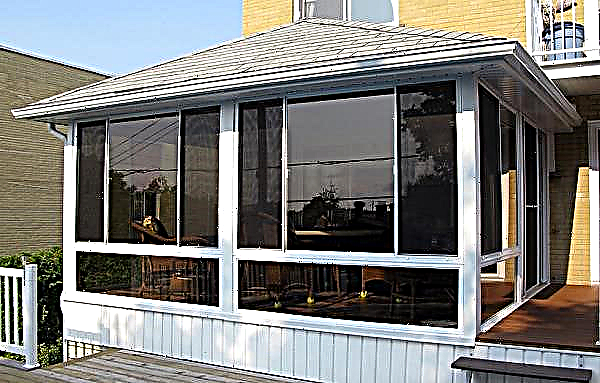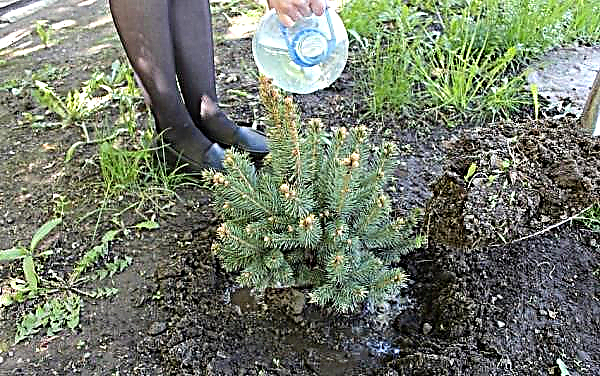In the garden, you can do without laying out paths, but most landowners do not like when, after rain, the paths are washed out and turn into a dirty puddle. To solve the problem in the household territory, you can lay out plastic tiles - an inexpensive and easy to install analogue of stone. From the article you will find out what types of coatings exist, their advantages and disadvantages, installation and maintenance rules.
Advantages and disadvantages of plastic tiles
- The popularity of using plastic tiles to cover garden paths is explained by the following advantages:
- lack of deformation in conditions of high humidity;
- resistance to low air temperature;
- Duration of operation - not less than 50 years;
- reasonable cost and opportunity to save;
- high strength;
- wear resistance and practicality;
- environmental friendliness of the material;
- the presence of colors and shapes for every taste;
- the possibility of repair at any time;
- lack of burnout and deformation from exposure to sunlight;
- easy care;
- simple and reliable operation;
- protection against sliding on a rough surface;
- the possibility of self-installation without the possession of special skills;
- light weight;
- the ability to assemble and disassemble.

- The disadvantages of coverage often relate to cheap low-quality species. Among the minuses include:
- high level of sliding on a smooth surface;
- high pressure deformation;
- fast abrasion of the top layer;
- the need for a foundation for some species;
- inappropriateness of use in expensive landscape design;
- low resistance to chemicals;
- faster trampling than stone;
- the requirement for wide seams between the elements in case of lengthening of the track;
- lower strength compared to stone;
- the need for mounting borders (otherwise the tile will creep).
Types of plastic tiles
Depending on the material of manufacture, the tile may be made of pure plastic or mixed.
By design features and purpose distinguish these types of inexpensive ways of arranging tracks:
- garden parquet;
- lawn grate;
- modular coating.
Did you know? The first semi-synthetic material in history, which gave impetus to the invention of plastic, was parkesin. Its discoverer, Alexander Parkes, mixed nitrocellulose, camphor and alcohol, which were heated to a fluid state, poured into molds and solidified.
Polymer plates
Conventional plastic plates differ from polymer ones. If the former are made entirely of synthetic material, then in the manufacture of the latter various natural additives (sand, quartz or wood), chloride and dyes are mixed with it. Without impurities, the tile looks cheap, wears out quickly, crumbles after exposure to low temperature and fades.
Plastic tracks are the most affordable and easy to install. For example, you can buy paving in the form of a roll, which is easily spread. In winter, it can be minimized, which will extend the service life. The option of polymer with additives will cost more, but its quality and durability are better, and the appearance is much more solid. Such plates can be used for the path leading to the house.
Did you know? The word "polymer" is of Greek origin. Literally, it is translated as "many parts", indicating the principle of the structure of plastic molecules consisting of monomers.
Garden parquet
Decking, or garden parquet, is an oblong tile modules that are laid horizontally or vertically. Each plate consists of 4-5 boards. They are made of polymer with the addition of wood flour. When buying, you should pay attention to the percentage ratio between the components, since there are various proportions that affect the cost and quality of products.
This type of coating has a rich exterior, and with the help of fasteners you can create an original ornament. Decking requires careful alignment of the base under it.
Important! The higher the wood content in the garden floor, the higher its moisture resistance will be.
Lawn grate
This coverage option is a grid in the shape of a square divided into cells of the same size.. The product is sold in green and is intended to strengthen the soil under the lawn and give it a neat appearance. Using the grate, you can form various compositions on the lawn, filling the cells with gravel or soil with grass seeds.
Connecting the parts together using special fasteners, you can adjust the size of the lawn. A similar design will save the track from dirt, provide good drainage to the ground and prevent it from weathering. A car that passes on such a lawn will not leave tire marks.
Modular coatings
The modular coating consists of squares measuring 0.5 × 0.5 m or 0.3 × 0.3 m with a thickness of up to 15 mm. They have a corrugated surface that has slits along or across. The material is suitable for creating paths, covering children's and sports grounds, recreation areas, areas around the reservoir.
Stages of the construction of the track
In order to build a track in the country from plastic, you need to observe the following sequence of work:
- Pick up materials and tools.
- Prepare the base.
- Make the correct mount.
Did you know? Fully synthetic plastic was developed by Leo Bakeland in 1907. Material in less than a year spread throughout the world and ushered in a new era in the history of industry.
Material selection and necessary tools
To lay the track, you need to prepare the following tools:
- roulette wheel;
- twine;
- pegs for marking;
- level;
- rubber tip hammer;
- ordinary hammer for formwork;
- hacksaw;
- a concrete mixer or a container for mixing cement (if a foundation is planned);
- beacons for leveling the base;
- a shovel;
- the rule.
 If you do not plan to make a screed, then in the last three positions there is no need.
If you do not plan to make a screed, then in the last three positions there is no need.You will also need a list of certain materials:
- medium sized gravel;
- coarse sand (screenings);
- cement PTs-400;
- film or other nonwoven fabric;
- plates for the track;
- borders;
- pipes for drainage;
- boards and nails for formwork or foundation.
 This list may be reduced depending on the features of the installation of the foundation.
This list may be reduced depending on the features of the installation of the foundation.
Foundation preparation
Laying a support for a path from a garden parquet or tile includes the use of:
- concrete;
- gravel (crushed stone);
- sand;
- dry mix of sand and cement;
- not loose soil;
- boards.
The start of work for all types of coverage involves the following actions:
- Using a tape measure, twine and stakes, mark the boundaries of the site where the tile will be laid.
- Dig a trench 20 cm deep with a shovel within the marking.
- Extract the roots of the plants, tamp the bed.

It is possible to fill the concrete foundation without digging a hole, but in this case it is necessary to build the formwork. Such a path will be above ground level, which will allow rainwater to drain, but entering the path may cause inconvenience.
You need to proceed further according to the step-by-step instructions:
- The first layer is covered with sand.
- Then along the cultivated area lay small slides of concrete 5–7 cm high opposite each other. The distance between them should correspond to the width of the rule.
- Install lighthouses (buy ready-made or use improvised materials), check them with a level and leave to dry.
- The components are mixed in a concrete mixer or other tank based on the following proportions: 1 bucket of water per 1 shovel of cement and 5 shovels of coarse sand. The mass should have a thick porridge consistency. Recommended kneading time is 5-10 minutes.
- Concrete is poured to the level of lighthouses and leveled using the rule.
- When the foundation dries slightly, the beacons are pulled out, the holes are filled with cement and leveled again.
- Allow the base to dry completely.

The height of the foundation and tile should be equal to the depth of the pit. If gravel is used as a base, then it is poured into a ditch and leveled without using sand. Such a pillow will provide quality drainage.
Arranging a slope with a slope is technically more complicated and requires more time, and a temporary plastic cover (for example, for the season) can be laid without a hole and foundation, directly on the ground. The soil must be well tampered so that it does not creep. It is advisable to cover it with a film or non-woven material, otherwise weeds will germinate. Boards need to be laid out on a flat surface.
Important! The height difference of any foundation should not be more than 5 mm per 1 m².
Laying and installation rules
The installation process of the garden path consists of the following steps:
- At the edges of the pit lay pipes for drainage.
- Build a foundation of gravel or concrete.
- Lay out the backing.
- Install the tile, having thought over the drawing in advance. For tracks with a slope, work should start from the highest point.
- Fasten the modules with special elements.
- To level, tap with a rubber mallet. Check height using level.
- Facing the path with curbs so that they rise 5 cm above the path.
You can install a lawn grate on the ground, having previously leveled it, but still it is recommended to make a drainage layer of gravel and sand before the deck. If it is planned to drive a passenger car on the coating, such a layer should be made 20-30 cm thick, for freight transport - about 50 cm. If, after fastening the parts, the size is too large, you can cut off the excess with a hacksaw. Depending on the purpose, the grate is covered with fertile soil with grass seeds or gravel.
In the process of laying a modular coating, the construction of the foundation is also not necessary, but you can lay out a curb for additional fixation. It is enough to connect its parts and use a rubber mallet to level the surface. At the edges of the plugs and corners are mounted. Track rotation is performed only at right angles. Sand or a dry cement-sand mixture is poured into the holes.
Features of caring for a track made of plastic
Under normal conditions, a plastic tile is watered once a week with water from a hose in order to wash away the dirt. Sometimes weather conditions require you to participate in this procedure. So that the track does not wear out longer, it is better to collect it for the winter and bring it to the barn or other utility room.
Important! In summer, tiles heated under the sun may have a specific smell. To prevent this from happening, it can be washed periodically with cold water.
Thus, plastic tile is an inexpensive, sustainable and attractive in appearance option for arranging garden paths. The demand for such a coating is constantly growing due to the availability and ease of installation, but before buying it is important to evaluate the landscape features, the style of the territory and the materials of the surrounding objects, because plastic can simply not fit into the design.












